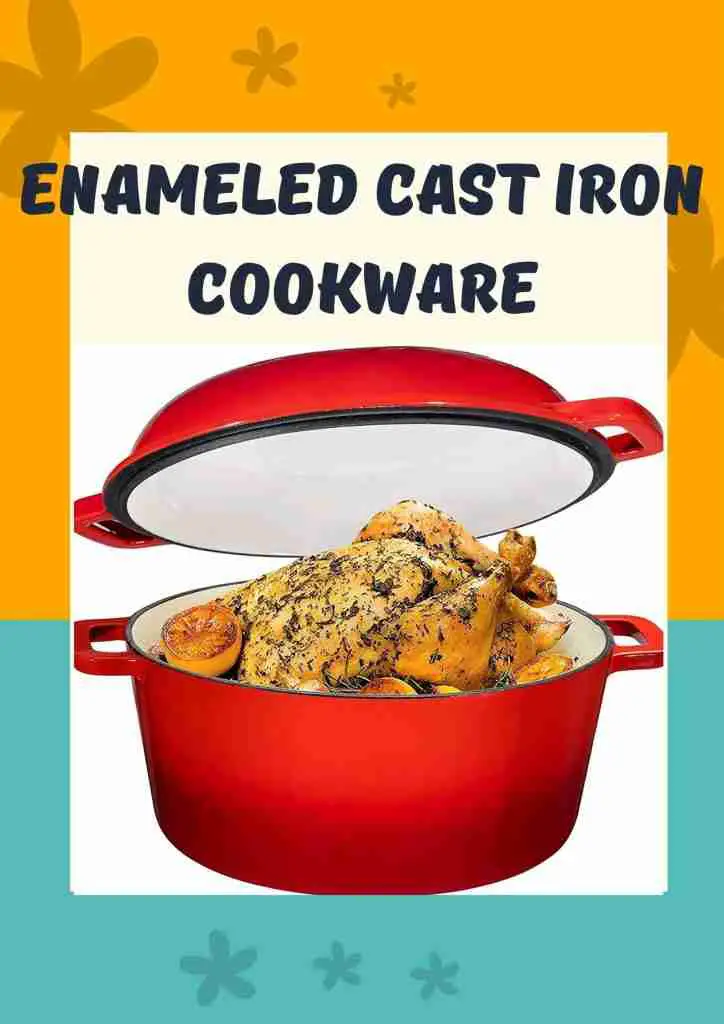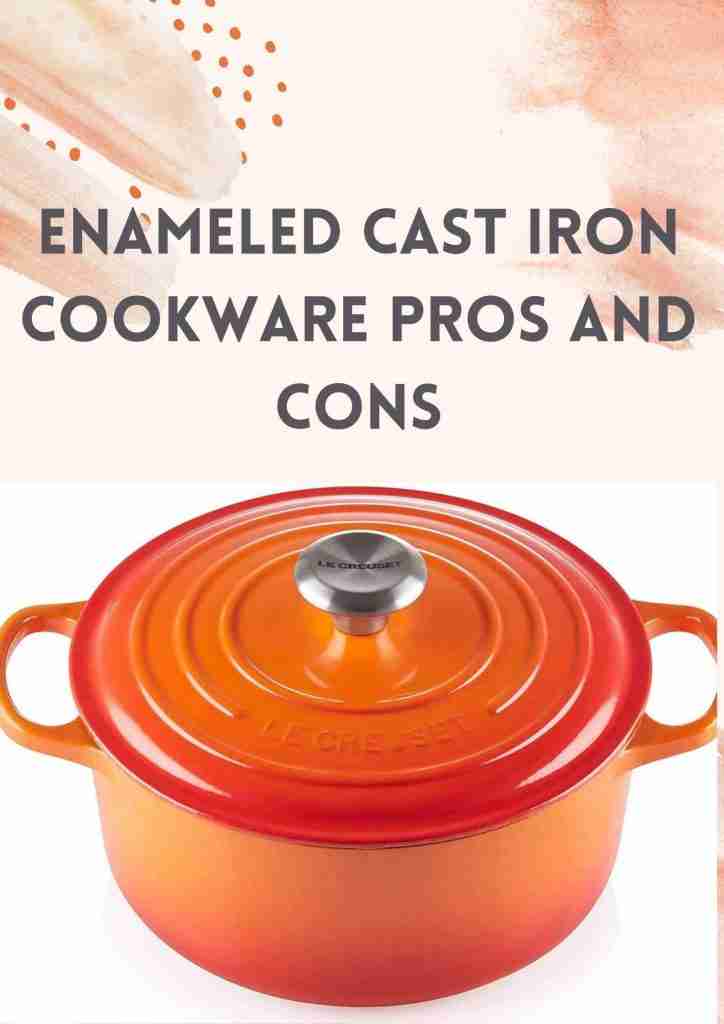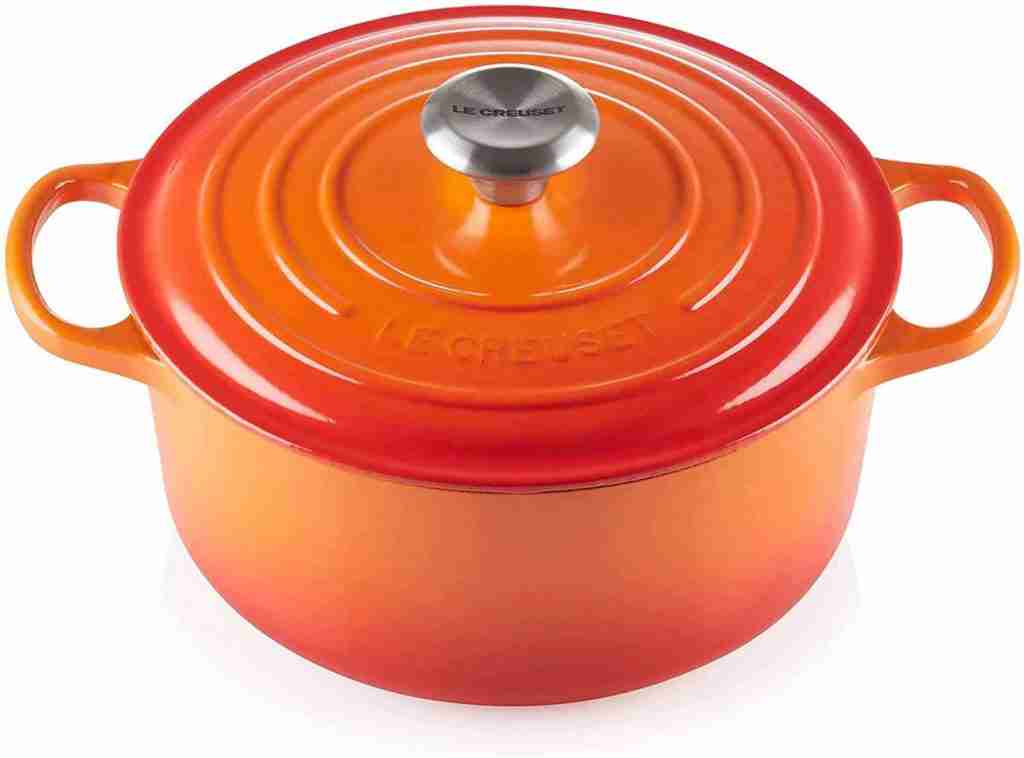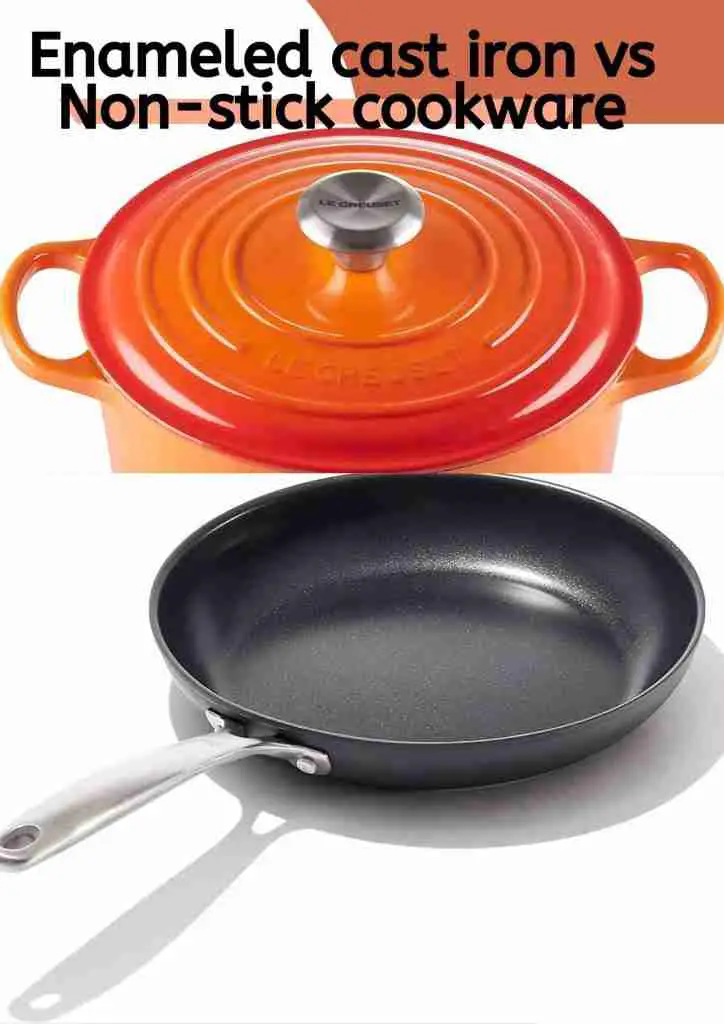People always consider their health before choosing cookware, because using improper cookware, particularly those that contain lead or cadmium or that leach toxic chemicals into your food can be harmful to your health.
“I’ve been considering getting enameled cast iron,” you might say. “Is it safe?” and “What are enameled cast iron cookware pros and cons?” Perhaps you’re asking this question because you don’t own an enameled cast-iron pot or pan and want to know the benefits and drawbacks before making a purchase.
Enameled cast iron pots and pans are a popular option for cookware because they are appealing. More information about this cookware is provided below to assist you to comprehend its effectiveness.
WHAT IS ENAMELED CAST IRON COOKWARE?

To truly understand enameled cast iron cookware pros and cons, let’s first define enameled cast iron.
Enameled cast iron is simply cast iron with a smooth porcelain surface bonded to the iron under high temperatures. The porcelain coating is like glass coating infused with raw cast iron.
One distinguishing feature of enameled cast iron cookware is its resistance to acidic and alkaline foods and its ability to cook, marinate, and refrigerate.
RELATED: DOES ENAMELED CAST IRON NEED TO BE SEASONED
RELATED: IS BLACK RESIDUE ON CAST IRON SKILLET HARMFUL?
RELATED: IS ENAMELED CAST IRON COOKWARE SAFE?
RELATED: ARE CAST IRON SKILLETS OVEN SAFE?
ENAMELED CAST IRON COOKWARE PROS AND CONS

In my previous article on the benefits and drawbacks of cast iron cookware, I was able to clarify that cast iron cookware comes in two varieties: enameled cast iron cookware and raw cast iron cookware.
Now, let’s look at the 8 major pros and cons of enameled cast iron cookware below:
| PROS OF ENAMELED CAST IRON COOKWARE | CONS OF ENAMELED CAST IRON COOKWARE |
| Enameled cast iron is easy to clean, unlike the raw cast iron cookware. | They take a longer time to heat up and don’t perform best under extremely high temperatures. |
| Enameled cast iron doesn’t require seasoning, unlike raw cast iron. | They are heavy, making them not ideal for senior citizens. |
| Enameled cast iron doesn’t rust, unlike the raw cast iron cookware. | Enameled cast iron shouldn’t be used on grill or campfire. |
| You can prepare acidic foods freely without fear of leaching iron, unlike raw cast iron. | Metal utensils shouldn’t be used on the surface of Enameled cast iron. |
| Enameled cast iron doesn’t have a non-reactive surface. | They are expensive compared to the raw cast iron cookware. |
| Enameled cast iron can go from stove to oven to table. | Enameled cast iron coating can be chipped creating fear of having impurities in your food. |
| Enameled cast iron comes in various shapes and colors. | Use low to medium heat for durability. |
| Enameled cast iron preserves the flavor of your food because of the continuous flow of heat and moisture. | Expect a small amount of staining in enameled cast iron. |
LE CREUSET ENAMELED CAST IRON

There are different brands when it comes to Enameled cast iron. We have:
Le Creuset Enameled cast iron
Lodge Enameled cast iron
Cuisinart Enameled cast iron
Bruntmor Enameled cast iron
Staub Enameled cast iron
Backcountry Enameled cast iron
Larder & Vine Enameled cast iron
T-FAL Enameled cast iron cookware
Landhaus Enameled cast iron
Klee Enameled cast iron
Ayesha Enameled cast iron
Epicurious Enameled cast iron
Michelangelo Enameled cast iron
Fercienda Enameled cast iron
However, we’d like to concentrate on Le Creuset’s enameled cast iron. The enameled cast iron cookware by Le Creuset is made in France. They have been in business since 1925 and are the industry leader in premium chip-resistant and highly durable enameled cast iron.
Le Creuset enameled cast iron is ready to use and does not require seasoning. They are simple to clean and resistant to dulling, cracking, and staining.
You’re safe because Enameled cast iron provides superior heat distribution and retention. Because of the black satin interior enamel, it is one-of-a-kind in that it can develop a patina over time to improve your cooking performance.
Despite its weight, the Le Creuset has ergonomic handles for easy lifting.
The Le Creuset cast iron cookware is oven safe up to 500°F and compatible with all cooktops. The black phenolic Signature knobs are oven safe up to 480°F and Classic knobs are oven safe up to 390°F.
Although they are dishwasher safe, we strongly advise that you wash them by hand for maximum longevity. The sand-colored interior of the Le Creuset enameled cast iron allows you to easily monitor the cooking process and prevents burning and sticking.
The Le Creuset large iron also has built-in lid stabilizers for a secure, no-slide fit.
Finally, the Le Creuset cast iron cookware, skillet, or grill pan is useful for small side dishes, small and large households, oat porridge, mushroom stews, sauces, and other recipes.
HOW TO TAKE CARE OF ENAMELED COOKWARE
You will notice from the pros and cons of enameled cast iron that it is simple to clean and maintain. However, this does not imply that you do not take care of your enameled cookware.
Enameled cast iron cookware becomes stained, food burns, especially baked food, and rust appears on the rims from time to time. What are you going to do?
To begin, we recommend not stacking your enameled cookware to avoid chipping, scratches, and even damage.
Allow your enameled cast iron cookware to cool before cleaning.
Although enameled cast iron is dishwasher safe, hand washing is strongly advised, particularly with warm soapy water.
We recommend using a nylon scrub brush to maintain the color and appearance of your cherished enameled cast iron.
Avoid using citrus-based cleaners and harsh dishwasher detergents because they can dull the exterior gloss of your enameled cast iron cookware.
To avoid scratching or chipping the porcelain coating, use nylon pads or scrapers to remove food residues rather than metal pads or utensils.
To remove stubborn baked-on food, bring 2 cups of water and 4 tablespoons of baking soda to a boil for a few minutes, then scrape the food loose with a pan scraper.
To avoid rust on the rims of your enameled cast iron cookware, do not leave it in damp areas. To avoid rust deposits, always drip dry the cookware.
Finally, to keep rust from forming on your enameled cast iron cookware, we recommend rubbing or applying cooking oil on a regular basis.
IS ENAMELED CAST IRON GOOD FOR COOKING?
Yes, of course, enameled cast iron is good for cooking because it contains no toxins that are harmful to your health.
Second, premium enameled cast iron brands such as Le Creuset and Lodge are made from superior quality raw materials that have been optimized to meet California safety 65 standards.
Finally, enameled cast iron cookware is suitable for a variety of stovetops and can cook the most popular everyday recipes without difficulty while preserving the food’s taste and flavor.
ENAMELED CAST IRON AND LEAD
There are numerous articles on the internet about the presence of lead or other impurities in enameled cast iron cookware.
Is there lead? That is the question we must answer. Is there a health risk to eating or cooking with enameled cast iron?
Before I go into specifics, my concern stems from two factors:
- The Country of origin or manufacture
- Materials used in the production of enameled cast iron
For the first issue, the country of origin, there are numerous prejudices against cookware made in China. Why is this the case?
Because we believe they do not adhere to safety standards during manufacturing, consumers prefer to purchase FDA-approved or standardized American-made enameled or cast iron cookware.
This is not always the case; for example, not all Lodge products are manufactured in the United States; all Lodge enameled cast iron products are manufactured in China and adhere to strict quality standards overseen by an American-owned third-party inspection company.
Second, the materials used in the manufacture of enameled cast iron do not pose a health risk due to technological advancements, particularly the porcelain glass-like coating, even when chipped.
The idea that enameled cast iron poses a health risk stems from old vintage enameled cast iron made in the 18th and early 19th centuries, which was manufactured with impurities and contains lead, so we recommend you only use them as decorations.
Finally, if you are truly concerned about whether cooking with enameled cast iron is healthy, we recommend meeting with a specialist lead test technician or scientist who can perform standard testing on your cookware and provide you with data-driven results so you can make healthy choices in cookware for your family.
ENAMELED CAST IRON VS NON-STICK

One thing is certain: different brands of enameled cast iron and nonstick cookware exist. One significant difference between enameled cast iron and nonstick cookware is that the majority of enameled cast iron is from Dutch ovens, whereas nonstick cookware can be in pots, pans, skillets, and so on.
Second, enameled cast iron is entirely made of cast iron, whereas non-stick can be made of aluminum, stainless steel, cast iron, carbon, granite, stoneware, and other materials.
The weight of enameled cast iron is greater than that of standard nonstick cookware.
Enameled cast iron cookware retains food flavor better than nonstick cookware.
Nonstick cookware, depending on the materials used, may be more suitable for high heat than enameled cast iron cookware.
In terms of health and safety, enameled cast iron cookware is superior to nonstick cookware because some nonstick cookware is made from inferior materials and may contain PFOA or PTFE.
To avoid using metal utensils on both enameled cast iron and nonstick cookware, use a silicone or wooden utensil.
Finally, both will last depending on the frequency of use and care or maintenance.
IS ENAMELED CAST IRON BETTER THAN REGULAR CAST IRON?
To truly understand whether enameled cast iron is superior to regular cast iron, I have taken the time at the beginning of this article to explain the pros and cons of enameled cast iron over regular cast iron so you can make an informed decision.
To be honest, no one is better than the other; it all depends on how frequently you use it, your maintenance culture, your cooking style, and the recipes you prepare on a regular basis.
